Say a word about organic photovoltaics. Part 1

In the middle of July 2013, in the glorious city of Erice, which is located far from civilization on a mountain in the west of Sicily, an extremely interesting scientific school “Nanostructures for Optics and Photonics” (or Nano-Structures for Optics and Photonics) was held. One of the reports on a happy coincidence turned out to be Organic photovotaic, presented by Prof. Uls Lemermer from the Karlsruhe Institute of Technology (KIT).
So, to be or not to be an "alternative" photovoltaic?
')
Introduction
A couple of months ago, an article about Gratzel ’s solar cells was published , but in the comments he met with a natural distrust and skepticism about the justification of investing in such solar cells. The main motivation of opponents is insufficient performance or efficiency of such elements as compared to silicon, they say, EROI is very bad . Although some estimates are collected and presented on the Wiki , it’s like the average temperature in a hospital. And according to this, based on the data presented by Professor Lemerrom, I would like to tell a little more detail about the "alternative" or - if you wish - not silicon photovoltaic, but first you still have to plunge into the world of numbers for normal silicon batteries in order to understand seek. And this article has as its goal a review of the already formed market of silicon solar cells.
Just want to make two important reservations. Firstly, KIT is famous for having in fact its production lines, on which technologies and the opinion of the aforementioned professor are often driven, I believe, authoritatively. Secondly, the EU diversifies development, and this is laid down in many framework programs. What does this mean? This means that even if you developed a solar battery with an efficiency of 5%, you will be able to receive funding to continue research, if, of course, 5% is not a theoretical (thermodynamic) limit.
And lastly, I will always mention this, one way or another, in the course of the narration: the investment costs in € / W, which can be reduced in two ways - by reducing the cost of production or by increasing the efficiency of solar panels.
Is there light after crystalline silicon?
I believe that one of the most weighted reviews on Habré was prepared by BarsMonster , so we will not dwell on this topic for a long time.
So, what is the "alternative" photovoltaics in comparison with the "classic"? Or how to break into generations known solar cells? It is very simple:
- Crystalline silicon based solar cells (EFG - Edge Defined Film fed Growth, RGS - Ribbon Growth on Substrate). The most ancient, we can say the stone age. The first developments can be attributed to the dawn of the era of microprocessor technology - the end of the 60s, the beginning of the 70s.
- Thin-film solar cells, such as amorphous silicon, silicon films, various options of environmentally unsafe, but intensively produced to date, based on cadmium and tellurium. They received an impetus to the development together with silicon, but only in the late 80s and early 90s they overstepped the 10% efficiency barrier.
- Alternative photovoltaics, including DSSC (sensitized solar cells or Gratzel solar panels habrahabr.ru/post/192468 ), flexible organic batteries (based on oligomers and polymers), including tandem solar cells, as well as a strange yet subspecies - solar elements based on quantum dots (nanoscale semiconductor particles).

Photovoltaics is not quite full, but clearly. Source of
And the logical question is: where is the place for this alternative photovoltaic? As already mentioned, two parameters must be kept in mind: efficiency and cost of production, which entails a reduction in the cost of electricity generated by such a battery in € / W. As we can see from the graphs below, crystalline silicon is, by all parameters, the most promising material for solar cells. Especially in the long run, when its investment cost can be reduced to 50 cents or less per watt. However, it is worth noting that the production of such high-purity or “solar” silicon is associated with enormous environmental risks, which are particularly baked in the EU and the US. Oh yes, in 5 minutes it will be said with a sarcastic smile that the production of cadmium-telluride, CdTe, batteries is growing - a paradox, but we will leave it on the conscience of Greenpeace and the administration of producing countries ...

Estimates of the effectiveness and cost of investment for various types of solar cells in the short, medium and long term.
Of course, today even amorphous silicon (production is cheaper and does not require “serious chemistry”) is at least comparable in price to crystal analogues, but still does not have sufficient efficiency to compete for some tasty market segment. But what is interesting in this diagram: non-silicon solar cells initially have a much lower investment cost and, accordingly, a lower cost of electricity generated with their help. This just gives hope to researchers and investors that in the future, it is possible by using processes such as roll-to-roll (read how to print a newspaper) to significantly reduce the costs of producing such elements. But I will tell about it in the second part devoted to alternatives.
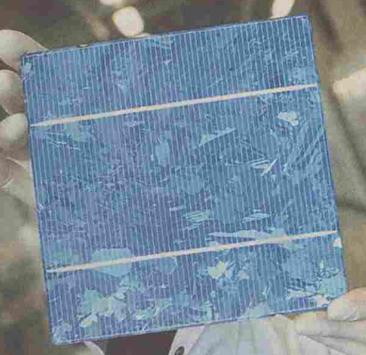
An example of a first-generation solar cell is polycrystalline silicon
But that's not all, in the case of flexible solar cells, and there are a lot of potential applications for such majority in the alternative group: from smart clothes that will charge your mobile phone in sunny weather ( for example ) to tents and awnings, able to power a small kettle in nature.
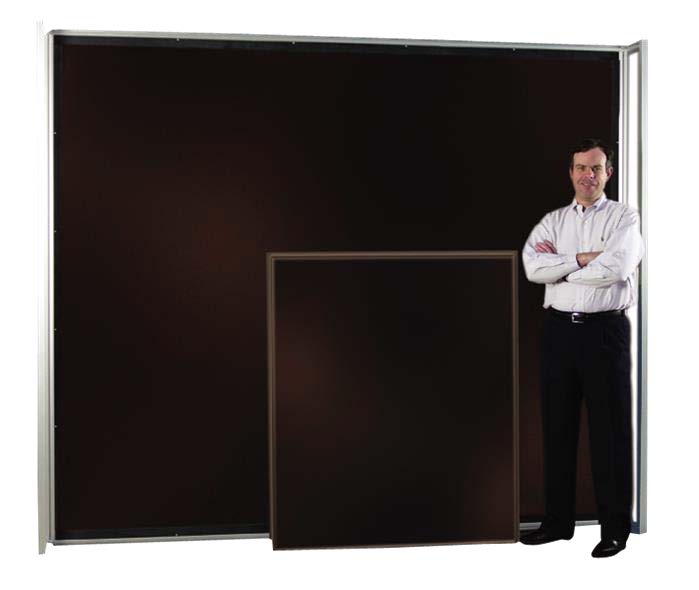
Second Generation Solar Panels
Taking into account the specific operating conditions - in the fields, so to speak - and also taking into account the desire of all leading manufacturers of mobile technology to reduce the thickness of a smartphone or ultrabook to the detriment of battery life, you must agree that this market segment can shoot very, very quickly.
But let us return from the fantasies of the paradise of the future to our sinful earth, more precisely, to the traditional solar elements.
The state of the modern market of solar energy.
As for some more accurate figures for solar cells of the first generation, they were presented in the form of a figure that even children can understand:
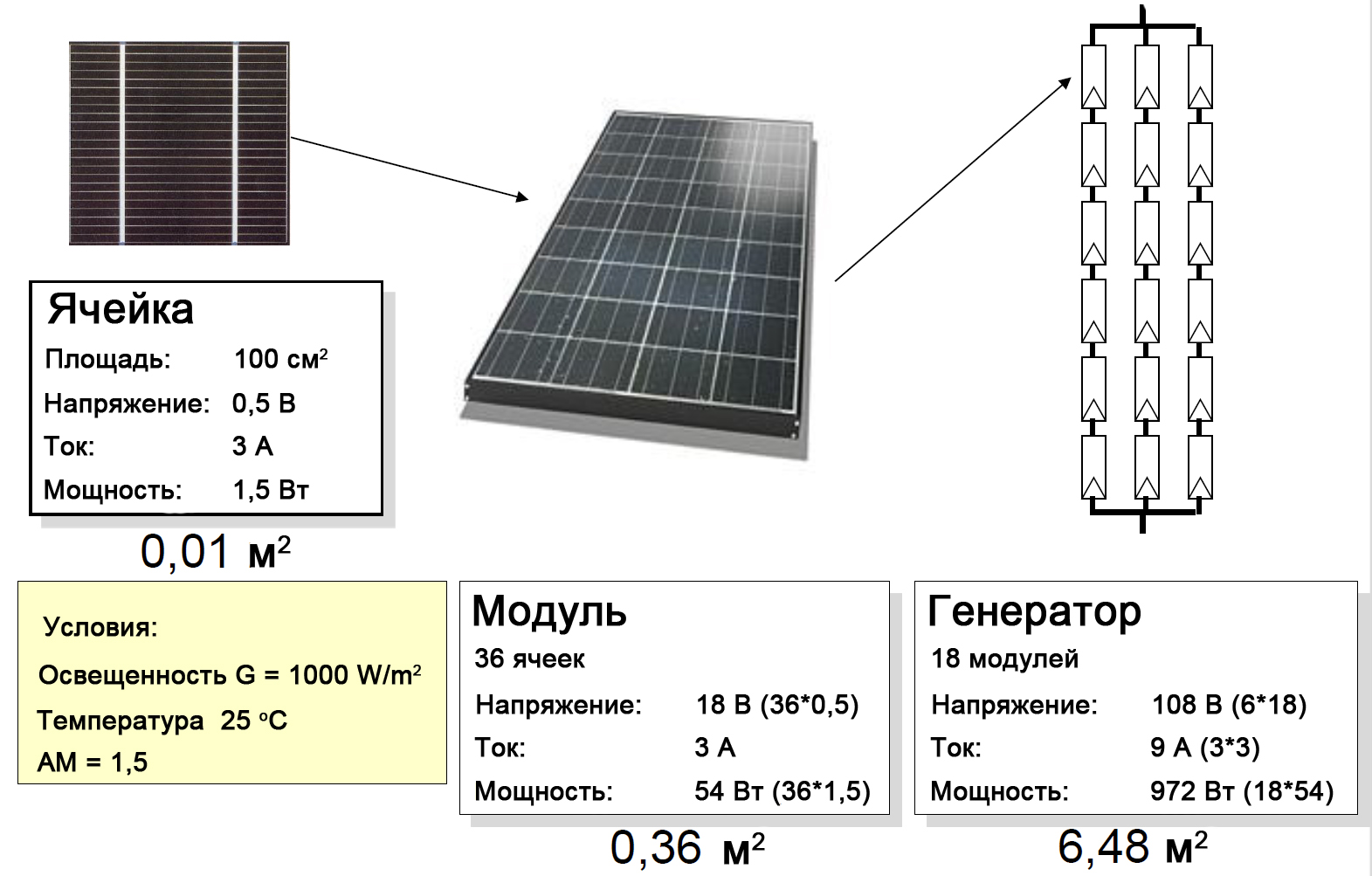
Nominal parameters of traditional solar cells
At the same time, the cost of a 54 W module usually does not exceed 60 euros, and each kWh of energy received costs the consumer less than 50 cents. The service life is enormous - it is usually tens of years (25-30 years is a standard), if something extraordinary does not happen - floods, hurricanes, Russian Epiphany frosts, etc. Well, then the batteries are disassembled, recycled, and new ones are manufactured from them.
Next, I would like to give some statistics. Of course, the share of mono-and poly-crystalline batteries is huge and totally eats up to 90% of the market, but look how the share of CdTe-batteries (environmentalists - ha-ha) has grown since the beginning of the 2000s, as other technologies slowly but surely began to sprout including alternative types of photovoltaics (in this case marked as others). And all this is not happening in the fat years of economic growth, when the money for the scientific wheel is flowing like water, but now, in our eyes, when the recession is still continuing in the EU and the USA.
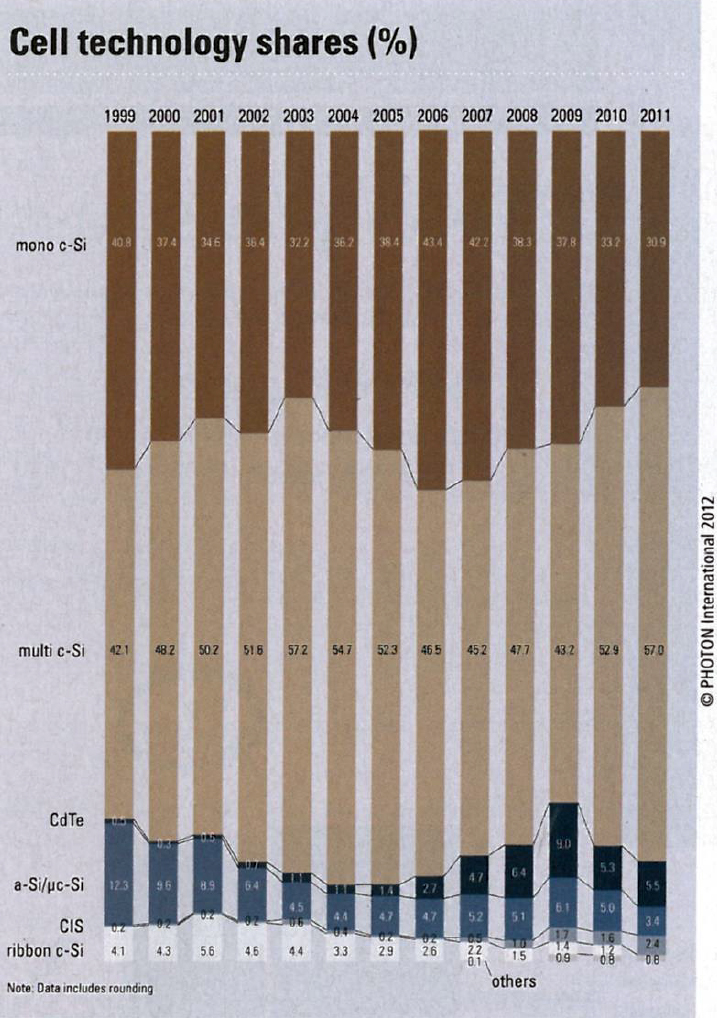
Solar market share for various types of batteries
Well, you can compare with the data given in the Wiki - a good match:
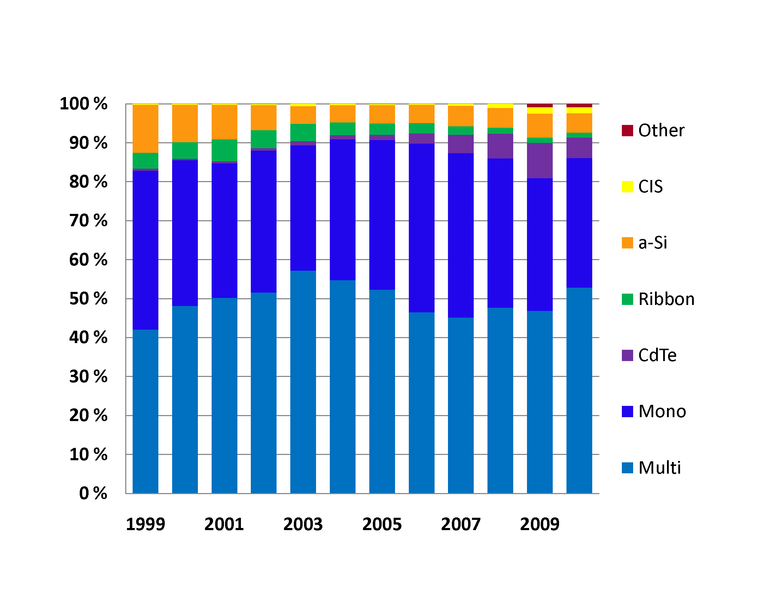
Where and what produce and set?
Of course, one could already guess that, as in the famous joke:
" - What are the three most popular words on the planet?
- Peace Labor may
- No, Made in China ", - most of the production of solar cells is concentrated in China. As of 2011, more than half of all modules produced during that year have a type plate: Made in China.

Annual production of first-generation solar cells
Whereas the main consumer of finished products is, oddly enough, Mother Europe. Among European countries, Germany is the undisputed leader, followed by Italy in the era of using the Sun as a universal source of energy, which is due, in general, to a favorable climate. Although, for example, in Sicily, where the school was held, the advantage is given to wind turbines.
I would also like to note that, for example, the share of Spain, where the climate favors the development of solar energy, has practically not increased the installed capacity of solar cells since 2008, whereas even China has significantly increased this parameter over the same period.
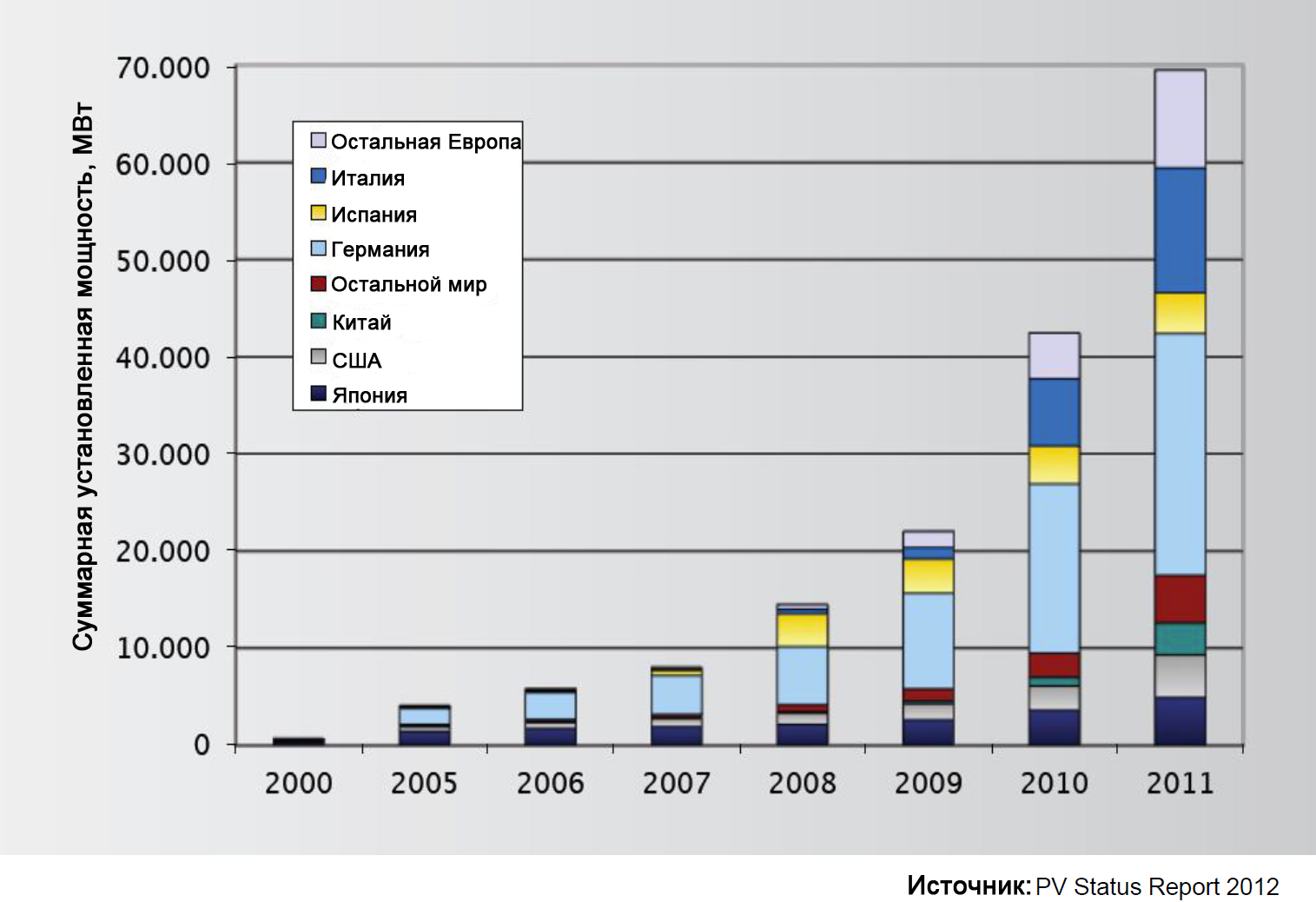
The total installed capacity of solar cells of the first generation
If Germany in the EU is the most significant consumer of alternative energy sources, in general, and solar, in particular, then over the past 7 years, we can estimate the extent to which module prices have fallen. So if the average retail price of a rooftop system was about 5,100 euros per kW of peak power, in the second quarter of 2013 it fell to 1,700 euros. 3 times in 7 years! Good result, it should be noted.
I would also like to draw attention to the fourth quarter of 2008. The crisis is raging in the US, banks are closing in the EU, it would seem that prices should remain at Q4 2008 and not go anywhere, because the enterprises are closed, the steamers are written off, and there is no money in the banks. But it turned out quite the opposite, a year after the crisis began, the price fell by 30% to less than 3,000 euros per kW.

The cost of kW peak power in euros over the past 7 years without VAT, as VAT can vary even between federated lands in Germany
And in conclusion, I would like to present calculations of the cost of electricity generated by such silicon solar cells. If you take the above amount for a solar panel, the lifetime of a solar panel at 20 years, 5% per year costs (for example, 4% loan interest and 1% maintenance cost of the battery itself), you get the following distribution of the cost of electricity produced per cent per kW * h:

The cost of electricity generated by the solar panel in cents per kWh: horizontally - the average degree of illumination of the area, vertically - the market value of the solar panel in dollars per kW of peak power ( Source )
Interim conclusion
What do we have in the end? At the moment, the market of silicon "classical" solar energy is formed, the share of crystalline silicon is more than 90%, and it will be difficult to press the main players on it (mainly China, EU, Japan and the USA).
What is the goal, or why are states donating solar energy programs? The reason is quite transparent: to diversify the structure of energy consumption as much as possible, to develop technologies and, in some cases (Germany, for example), to reduce the dependence of exports from neighboring regions (from Russia, in particular).
How in these conditions to live and develop "alternative" types of solar cells, which were mentioned at the very beginning? Is there a place in the shade of polycrystalline silicon? Or is all this self-indulgence that leads to nothing? I will try to give an answer through the prism of the technologies that are being developed at the moment.
And how will our hero deal with this?
All on viewing pictures of the second !
Sometimes briefly, and sometimes not so much about the news of science and technology, you can read on my Telegram channel - welcome;)
Source: https://habr.com/ru/post/202650/
All Articles